
Ahaetulla nasuta, also known as Sri Lankan green vine snake and long-nosed whip snake, is a venomous, slender green tree snake endemic to Sri Lanka.

The Andrenidae are a large, nearly cosmopolitan family of solitary, ground-nesting bees. Most of the family's diversity is located in temperate or arid areas. It includes some enormous genera. One of the subfamilies, Oxaeinae, is so different in appearance that they were typically accorded family status, but careful phylogenetic analysis reveals them to be an offshoot within the Andrenidae, very close to the Andreninae.

The long-nosed bandicoot, a marsupial, is a species of bandicoot found in eastern Australia, from north Queensland along the east coast to Victoria. Around 40 centimetres (16 in) long, it is sandy- or grey-brown with a long snouty nose. Omnivorous, it forages for invertebrates, fungi and plants at night.

Andrena is a genus of bees in the family Andrenidae. With over 1,500 species, it is one of the largest genera of animals. It is a strongly monophyletic group that is difficult to split into more manageable divisions; currently, Andrena is organized into 104 subgenera. It is nearly worldwide in distribution, with the notable exceptions of Oceania and South America. Bees in this genus are commonly known as mining bees due to their ground-nesting lifestyle.
Odorrana nasuta is a species of frogs in the family Ranidae that is endemic to Hainan, China. It occurs near streams in forested regions at elevations of 350–850 m (1,150–2,790 ft) asl. Breeding takes place in streams. It is threatened by habitat loss caused by smallholder farming activities and clear-cutting of forests.

The large-nosed wood turtle is one of nine species of turtle in the genus Rhinoclemmys of the family Geoemydidae. It is found in Colombia and Ecuador.

The bee subfamily Andreninae is a nearly cosmopolitan lineage, with most of its diversity in one genus, Andrena, which contains over 1500 species. The remaining four genera in the subfamily only contain a total of 9 species.
"Dixeya" nasuta is a species of gorgonopsian therapsids from the Late Permian of southern Africa. Fossils have been found from Malawi, Zambia, and Tanzania. It was originally named as a species of the genus Dixeya, but this genus is now considered a synonym of Aelurognathus, leaving "Dixeya" nasuta without a formal genus name. The genus "Njalila" was proposed for the species in a thesis, but has not been formally published.
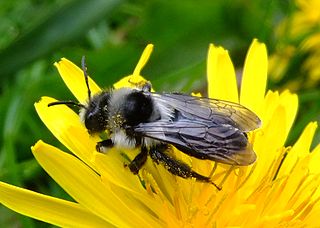
The ashy mining bee, also known as the Danubian miner or grey mining bee, is a species of sand bee found in Europe. Its distinctive colouring makes it one of the most easily recognised of the genus. The females are black, with two broad grey hair bands across the thorax. The male is also black although the thorax is entirely covered with grey hairs. The male has a tuft of white hairs on the lower face and white hairs on all femora while the female has white hairs only on the front femora. The female has twelve segments to their antennae and the male has thirteen.
Mesoclemmys nasuta is a species of turtle that lives in Bolivia, Colombia, Peru, Brazil and the Guyanas.
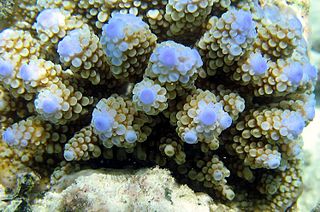
Acropora nasuta is a species of branching stony coral in the family Acroporidae. It is native to the western and central Indo-Pacific where it is found in shallow reef habitats. Like other corals of the genus Acropora, it is susceptible to coral bleaching and coral diseases and the IUCN has listed it as being "Near Threatened".

Andrena trimmerana, Trimmer's mining bee, is a species of mining bee from the family Andrenidae. It occurs in the western Palearctic but its true status in some areas is muddled due to issues of taxonomy and misidentification.
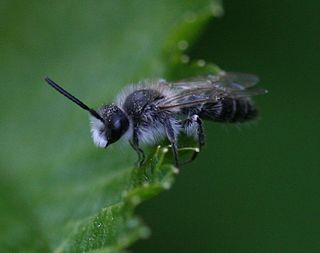
The bearded miner bee is a species of miner bee in the family Andrenidae. It is found in Europe and Northern Asia and North America. Other common names include the long-lipped andrena and the sandpit mining bee.
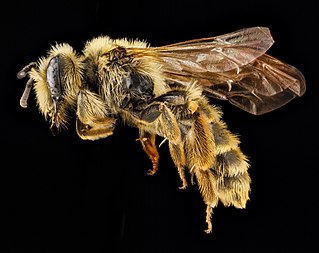
The death camas miner bee, is a species of miner bee in the family Andrenidae. Another common name for this species is death camas andrena. It is found in North America. It specialises in feeding on the highly poisonous Toxicoscordion venenosum and is possibly the only bee that can tolerate its toxins.
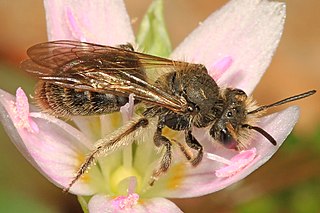
Andrena erigeniae, the spring beauty miner bee or spring beauty andrena is a species of miner bee native to North America.
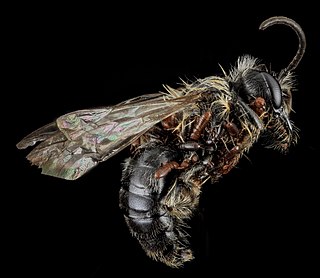
The Carlinville miner bee is a species of miner bee in the family Andrenidae. Another common name for this species is Carlin's miner. It is found in North America.

Andrena lagopus is a species of mining bee belonging to the family of Andrenidae.












